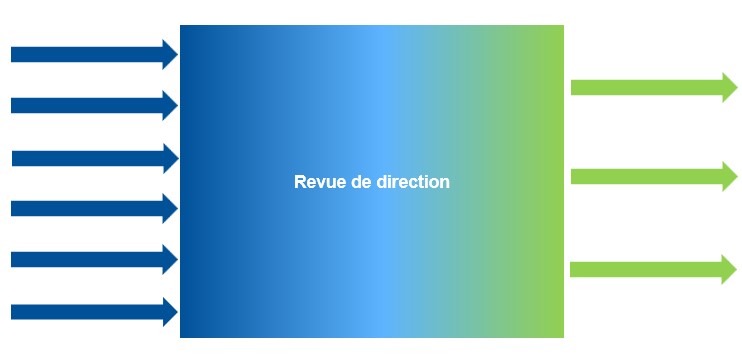THE AGILE AND CONTINUOUS MANAGEMENT REVIEW, A POWERFUL TOOL FOR BUSINESS MANAGEMENT
The management review is one of the requirements of ISO management system standards such as ISO 9001, ISO 14001 and ISO 45001. But what is the meaning and philosophy of the management review?

The Management Review is often perceived as a very (very) long session (!) during which a large number of participants, including management, take stock of a large number of indicators covering a long period, for example the previous year.
First of all, it is important to note that the management review is more of a process a meeting. The term "review" is not necessarily synonymous with "meeting".
There are many other ways of doing a management review!
ISO standards give relatively little information on "how" to carry out a management review. However, they do explicitly define the inputs and outputs of the management review, and this is a requirement for certification.
The input elements of the Management Review are 9:
- Previous management reviews
- Changing the stakes
- Management system performance
- Adequacy of resources
- Effectiveness of actions in the face of risks and opportunities
- Opportunities for improvement
The output elements There are 3 types of management review:
- Opportunities for improvement
- Changes needed to the quality management system
- Resource requirements
In short, the aim of the management review is to take stock of the performance of the management system, at what is known as the "high level" or "bird view" or "helicopter view". It is really a summary analysis at a global level. The aim here is not to go into too much detail, but to analyse the overall operation of your quality, safety and/or environmental management system.
A few tips to make the management review process more effective agile and easy to digest :
Rethinking frequency of your management review: what is the right frequency for carrying out the management review? The answer lies partly in how quickly your management system changes. If the scope of your management system is changing rapidly (new products, new services, new sites, etc), a frequency shorter than one year may be appropriate. The standard talks about periodic intervals but does not explicitly stipulate a quantified frequency. In practice, ISO-certified companies often carry out management reviews once a year.
If you are finalising the management review in the form of a session (face-to-face or remote), good practice in conducting meetings applies:
80% is prepared in advance of the session. For example, you could imagine collecting participants' input before the session by means of an online form. This way, your session will be much more effective, as you will be able to focus only on the key points to be discussed.
In many companies, the quality manager prepares the management review on his own and has his own conclusions validated at a meeting or by email. While this has the advantage of being quick, it has the considerable disadvantage of not involving those involved in quality, safety or environmental management. The management review should be seen as a real opportunity to take a step back and discuss in depth the concepts of the organisation's quality and safety culture.
Kill several birds with one stone: You can take advantage of the management review to review elements such as company policy or updating the scope of your quality management system.
Good practice in defining indicators also applies to the management review. By selecting indicators :
- Reliable
- Understandable
- Relevant
- To date
... you'll save a lot of time when analysing your management review.
Invite the relevant participants to the management review. Who should take part in the management review? Obviously, top management. The active participation of management in the management review and its use as a genuine strategic decision-making tool by management is proof of the leadership required by the chapter 5 of ISO 9001.
Is the management review an audit?
The management review can indeed be seen as a kind of periodic internal review, a milestone that ensures continuous improvement, with the difference that the principle of independence does not apply here. It is a self-assessment by the people managing or involved in the quality management system.
The management review alone is necessary, but not sufficient, to bring a quality management system to life.
It should be noted that the management review illustrates the quality management principle of "evidence-based decision making", since the decisions taken during the management review are based on input.
What is the purpose of the management review? if the company already has numerous strategy meetings, staff meetings, team meetings, etc.?
It is likely that the meetings already in place cover part of what is required by the management review standards. However, management review takes place at a much more global level.
The management review is also intended as a "safeguard", an additional level of security in the event that the other processes of the management system have not identified and planned the relevant improvements, for example because the participants in the sectorial processes did not have sufficient decision-making rights within the company.
One of the key outputs of the management review is the assessment of the need for resources. Depending on the results of the analysis, resource requirements may be identified. By resource, we mean :
- Human resources or skills development for existing staff
- IT tools and resources needed such as quality management software, safety management software, process modelling software and continuous improvement software.
- Infrastructure needs (machines, tools, equipment)
- Need for financial resources for example, to call on external resources such as consultants, experts, specialists, etc.
We hope you enjoy your management review!